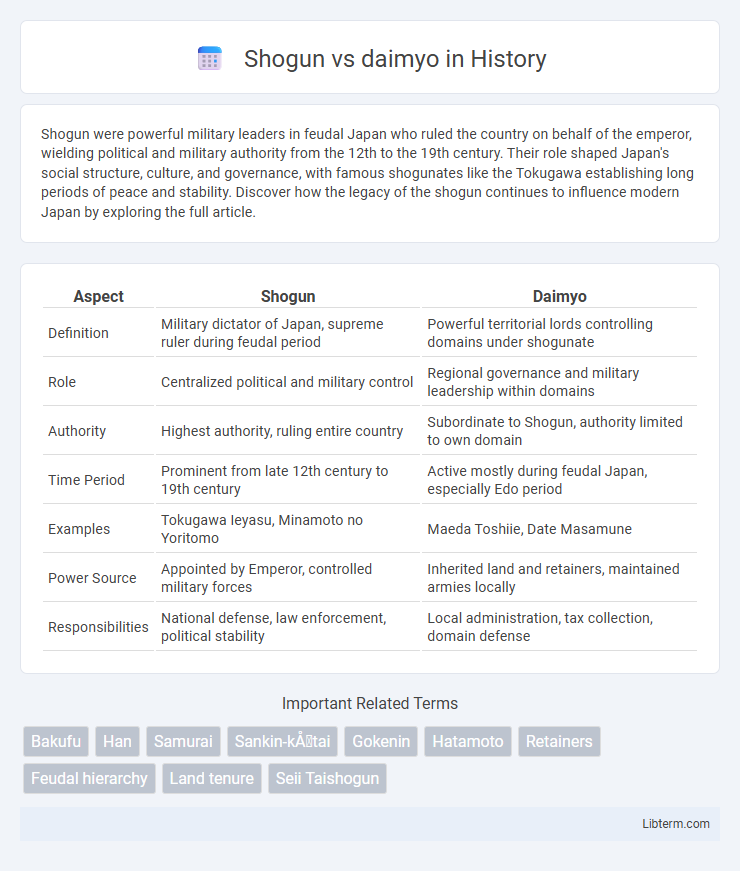Shogun were powerful military leaders in feudal Japan who ruled the country on behalf of the emperor, wielding political and military authority from the 12th to the 19th century. Their role shaped Japan's social structure, culture, and governance, with famous shogunates like the Tokugawa establishing long periods of peace and stability. Discover how the legacy of the shogun continues to influence modern Japan by exploring the full article.
Table of Comparison
| Aspect | Shogun | Daimyo |
|---|---|---|
| Definition | Military dictator of Japan, supreme ruler during feudal period | Powerful territorial lords controlling domains under shogunate |
| Role | Centralized political and military control | Regional governance and military leadership within domains |
| Authority | Highest authority, ruling entire country | Subordinate to Shogun, authority limited to own domain |
| Time Period | Prominent from late 12th century to 19th century | Active mostly during feudal Japan, especially Edo period |
| Examples | Tokugawa Ieyasu, Minamoto no Yoritomo | Maeda Toshiie, Date Masamune |
| Power Source | Appointed by Emperor, controlled military forces | Inherited land and retainers, maintained armies locally |
| Responsibilities | National defense, law enforcement, political stability | Local administration, tax collection, domain defense |
Introduction to Shogun and Daimyo
The Shogun was the military dictator of feudal Japan, wielding supreme political and military power from the late 12th century until the mid-19th century. Daimyo were powerful territorial lords who controlled vast landholdings and maintained private armies of samurai under the shogunate's authority. This hierarchical structure allowed the Shogun to govern Japan through the loyalty and military strength of the daimyo.
Origins and Historical Background
The shogun, originating from the early Heian period as a military commander appointed by the emperor, evolved into the de facto ruler of Japan during the Kamakura period, holding supreme military authority. Daimyo, powerful feudal lords tracing back to the Muromachi period, managed vast landholdings and samurai retainers under the shogunate's rule. The shogunate system established a clear hierarchy where the shogun wielded national power, while daimyo controlled regional domains, shaping Japan's feudal political structure.
Power Structure in Feudal Japan
In feudal Japan, the shogun held the supreme military authority, effectively controlling the country's governance and commanding the samurai class. Daimyo were powerful regional lords who governed their own domains but remained subordinate to the shogun's centralized power. The shogun's authority depended on the loyalty and military support of the daimyo, creating a hierarchical system where regional control was balanced with national supremacy.
Roles and Responsibilities
The Shogun held the highest military authority in feudal Japan, overseeing national defense, political governance, and controlling samurai armies. Daimyo were powerful regional lords responsible for managing their own domains, maintaining local order, and collecting taxes while pledging loyalty to the Shogun. The Shogun coordinated military campaigns and foreign policy, whereas daimyo focused on economic development and administration within their territories.
Military Authority and Control
The shogun held the supreme military authority in feudal Japan, commanding vast armies and overseeing national defense, whereas daimyo were powerful regional lords controlling localized samurai forces under the shogun's overarching rule. Shoguns exercised centralized military command and strategic decision-making, while daimyo managed their domain's military resources, enforced law, and maintained order within their territories. The hierarchical relationship ensured that daimyo remained loyal military vassals, supporting the shogun's campaigns and maintaining stability across feudal Japan.
Political Influence and Governance
Shoguns wielded supreme military and political authority in feudal Japan, effectively ruling as de facto leaders while the emperor remained a symbolic figurehead. Daimyo, powerful regional lords, exercised autonomous control over their domains but owed military allegiance to the shogun, facilitating a hierarchical governance structure. The shogunate centralized power by regulating daimyo activities through policies such as sankin-kotai, ensuring political stability and consolidating control over Japan.
Land Ownership and Wealth Distribution
Shogun held supreme authority over Japan's land, controlling vast territories and redistributing land to loyal daimyo as vassals, reinforcing the feudal hierarchy. Daimyo managed their own domains, owning significant landholdings and generating wealth through agricultural production and taxation of peasants. The wealth distribution system centralized power under the shogunate, while enabling daimyo economic independence within their fiefs.
Relationships with Samurai and Peasants
Shoguns held supreme military authority and governed samurai through hierarchical control, commanding loyalty and enforcing strict codes of conduct, while daimyo managed regional territories with autonomous power over their samurai retainers. Samurai under shoguns were often engaged in national governance and military campaigns, whereas those serving daimyo focused on local defense and administration. Peasants were generally subject to daimyo authority for land cultivation and taxation, with shoguns influencing peasant life indirectly through overarching policies and regional daimyo governance.
Shogun vs Daimyo: Key Differences
The Shogun was the military dictator of Japan, holding the highest power and controlling the samurai army, while the Daimyo were powerful regional lords who governed individual domains under the Shogun's authority. Shoguns centralized political and military power, overseeing national governance and foreign diplomacy, whereas Daimyo managed local administration, collected taxes, and maintained their own samurai forces. The Shogun's influence extended across the entire country, contrasting with the Daimyo's regional dominance within their specific territories.
Legacy and Impact on Japanese History
The shogun, as Japan's military ruler, centralized power and maintained political stability from the 12th to 19th centuries, shaping feudal governance and influencing samurai culture. Daimyos, as powerful regional lords, controlled local domains and upheld the shogunate's authority while fostering economic growth and cultural development within their territories. The legacy of the shogun system established a framework for modern Japan's political structure, whereas daimyo contributed to regional diversity and the preservation of traditional arts.
Shogun Infographic

 libterm.com
libterm.com